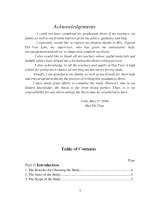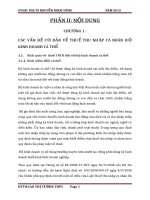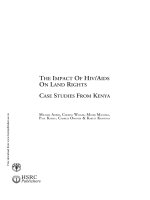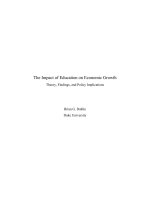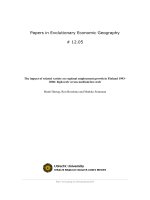The impact of teachers' quality on RUS students in terms of speaking skill = Tác động của chất lượng giáo viên đối với việc học nói của học sinh trung học ở vùn
Bạn đang xem bản rút gọn của tài liệu. Xem và tải ngay bản đầy đủ của tài liệu tại đây (557.05 KB, 51 trang )
1
Vietnam national university, Hanoi
University of Languages and international studies
faculty of Post-graduate Studies
ĐÀO XUÂN HÙNG
The impact of teachers’ quality
On rus students in terms of speaking skill
(Tác động của chất lượng giáo viên đối với việc học nói của học sinh
trung học ở vùng nông thôn)
M.A MINOR THESIS
Field: English Teaching Methodology
Code: 60 14 10
Hanoi, 2010
2
Vietnam national university, Hanoi
University of Languages and international studies
faculty of Post-graduate Studies
ĐÀO XUÂN HÙNG
The impact of teachers’ quality
On rus students in terms of speaking skill
(Tác động của chất lượng giáo viên đối với việc học nói của học sinh
trung học ở vùng nông thôn)
M.A MINOR THESIS
Field: English Teaching Methodology
Code: 60 14 10
Cohort: MA 17
Supervisor: Hà Cẩm Tâm (Ph.D)
Hanoi, 2010
6
TABLE OF CONTENTS
Headings
Pages
Acknowledgment
i
Abstract
ii
Table of contents
iii
List of Abbreviations
vi
CHAPTER ONE: INTRODUCTION
1.1. Rationale for the study
1
1.2. Aims of the study
2
1.3. Significance of the study
2
1.4. Scope of the study
2
1.5. Methodology
2
1.6. Organization of the study
2
CHAPTER TWO: LITERATURE REVIEW
2.1. An overview of speaking skill.
4
2.1.1. Speaking definitions.
4
2.1.2. Characteristics of beginning level learners .
4
2.1.3. The MOET principles of teaching speaking skill
5
2.1.4. Principles for teaching speaking to beginning learners.
6
2.1.5. Elements needed for speaking skill development.
8
2.2. Language Teaching Methods
9
2.2.1. The Grammar Translation Method
10
2.2.2. The Direct Method and Audiolingualism
10
2.2.3.Communication in language teaching
11
2.2.4. Principles of the communicative approach
12
2.3. The language of the EFL teacher
14
7
2.3.1. Introduction
14
2.3.2. The main characteristics of the language used by the EFL
teachers
14
2.3.3. The language for opening/closing the lesson
15
2.3.4. The language for instructions
16
2.4. Issues of teacher development in Vietnam.
17
CHAPTER THREE: THE STUDY
3.1. Research question
20
3.2. Design of the study
20
3.2.1. Data Collection Instruments
20
3.2.2. Participants
20
3.2.3. Data Collection Procedure
21
3.3. Analytical framework
22
3.3.1. The language for the opening of the lessons.
22
3.3.2. The language for the closing of the lessons.
23
3.3.3. The language for instructions
24
3.3.4 Principles for teaching speaking to beginners.
24
3.3.5. Principles of the communicative approach.
24
3.3.6. Elements needed for speaking skill development.
25
3.4. Data analysis and discussion
25
3.4.1. The language for opening and closing of the lessons.
25
3.4.2. The language for instructions.
26
3.4.3. Principles for teaching speaking to beginners
29
3.4.4. Principles of communicative approach
30
3.4.5. Elements needed for speaking skill development
32
CHAPTER FOUR: CONCLUSION
4.1. Major findings
34
4.2. Implications
35
4.3. Limitations of the study
36
4.4. Suggestions for further study
36
8
References
37
Appendices
I
Appendix A
I
Appendix B
II
Appendix 1
IV
Appendix 2
V
9
LIST OF ABBREVIATIONS
CLT Communicative language teaching
CL Classroom language
CSs Communication skills
EFL English as a foreign language
ESL English as a second language
MOET The Ministry of Education and Training
RUS Rural upper-secondary school
TD Teacher development
TEFL Teaching English as a foreign language
UEE The University Entrance Exam
UFE The upper-secondary final exam
10
CHAPTER ONE: INTRODUCTION
1.1. Rationales
English has undergone many changes in teaching and learning in Vietnam over the
last few decades. Demand for learning English even becomes stronger when Vietnam
applies its open door policy. English turns out to be the leading factor in a smaller and
smaller world. Learners want to be able to master English to a high level of accuracy and
fluency. Employers too insist that their employees have good English language skills,
fluency in English is a prerequisite for success and advancement in many fields of
employment in today‟s world.
However, in rural upper-secondary schools (RUSs), though English is a compulsory
subject, it fails to equip students with enough knowledge and skills, especially speaking
skill. Even, The Ministry of Education and Training (MOET) has developed new
textbooks, equipped more facilities to better the teaching and learning English, the fact is
not changed. This is because:
First, the goals of learning English and foreign language in general are set by the
MOET. It can be translated as follows: To provide some basic knowledge about foreign
languages in order to help school students to communicate and to use them as a key to
science and technology. These goals are too general and vague to be easily put into
practice.
Second, Hubbard (1987, p.24, Burn, 1981, p.2, as cited in Thuoc, 1988, p.48) stated
that “the teacher is a means to an end: An instrument to see that learning takes place. As a
human being, he is of course a subtle and sensitive instrument who cannot be satisfactorily
replaced by a mechanical aid…” However, teachers‟ qualifications haven‟t been strictly
considered and developed. That is the reason why teachers have failed to meet the demand
of teaching English in general and teaching speaking in particular.
In fact, teachers are the people who know the languages, select the new material to
be learnt, and present it as clearly and memorably as possible. Also, teachers work as
conductors who give students opportunities to participate, to practise. In addition, teachers
act as guides in organising and motivating students‟ language activities. The question is
how teachers do those without being equipped with proper knowledge and skills. I think
that it is essential to do research on teachers‟ qualifications so I decided on choosing the
topic “the impact of teachers‟ qualifications on RUS students in terms of speaking skill”.
11
1.2. The aims of the study
- The aims of this study are as follows:
a) to examine the impact of teachers‟ instructions on RUS students in terms of
speaking skill.
b) to suggest a possible basis for RUS teachers‟ ELT effectiveness.
1.3. The significance of the study.
The study helps point out some impacts of teachers‟ instructions on RUS students in
terms of speaking skill. It would enable teachers to be aware of the necessity of their
instructions to the students‟ speaking skill development. It is also hoped that the study
would make some suggestions for teachers‟ effectiveness which is considered by many
linguists, educators and researchers as one of the most crucial ways to develop students‟
speaking skill.
1.4. The scope of the study
- Firstly, The impacts on students‟ development in terms of speaking skill is a very
complicated problem, it composes of many factors. Therefore, my thesis will focus mainly
on rural Teachers‟ qualifications-those are teachers‟ instructions; the effectiveness of
teachers‟ method practice. The effectiveness here can be understood as the comparison
between goal setting and goal achievement. If the goal setting matches with the goal
achievement, the teaching will be considered effective and vice versa.
- Secondly, more attention will be paid to the theory and description, which will make
RUS teachers be aware of their problems and have directions to improve and develop in
order to better the teaching.
- Thirdly, with the limitation of time and references, I shall only venture to suggest
some theoretical solutions for RUS teachers‟ effectiveness in terms of CL and method
practice.
1.5. Method of the study
- Classroom observation: Teachers‟ instructions
- Guided interview.
1.6. Organization of the study
The study consists of four chapters:
12
- Chapter one: Introduction which contains rationale, scope, aims, significance,
methodology and organization of the study.
- Chapter two: Literature review establishes the basic theoretical ground from the
literature on speaking skills, principles of teaching speaking skills for beginning learners,
the MOET principles of teaching speaking skill, principles in teaching using CLT, common
methods and teachers‟ language instructions, and teacher development (TD) are clearly
described.
- Chapter three: The study describes the overall picture of how the research was
carried out from choosing the research question, the participants, the data collection
instrument to gather data and analysis, results and discussion to make it more
comprehensible.
- Chapter four: Conclusion reviews the main findings of the study, suggests some
solutions, and ends with some suggestions for further research.
13
CHAPTER TWO: LITERATURE REVIEW
This chapter discusses the theory and research into which this study bases on. The
chapter is divided into four sections. The first section provides an overview of speaking
skill. The second section presents language teaching methods. The third section is about the
language of the English as a foreign language (EFL) teacher. And the last section gives
Issues of teacher development in Vietnam.
2.1. An overview of speaking skill
2.1.1. Speaking definitions
Bailey (2003, p.2) defined that speaking consists of producing systematic verbal
utterances to convey meaning (Utterances are simply things people say). Florez (1999, p.1,
as cited in Bailey, 2003, p.2) stated that speaking is “an interactive process of constructing
meaning that involves producing and receiving and processing information”.
Bailey (2003, p.2) also pointed out that speaking is such a basic human behavior that
we don‟t stop to analyze if there is not anything noticeable about it. What we ignore is a
number of physical, mental, psychological, social, and cultural factors that must all
combine together when we speak. People will have a great influence when they hear a lucid
speaker in a second or foreign language.
2.1.2. Characteristics of beginning level learners
What does it mean to be a “beginning” or a “lower-level” language learner?
According to the American council on the Teaching of Foreign Languages (as cited in
Bailey, 2005, p.30), beginning level students can be characterized as follows:
- Oral production consists of isolated words and learned phrases within very
predictable areas of need.
- Vocabulary is sufficient only for handling simple, elementary needs and
expressing basic courtesies.
- Utterances rarely consist of more than two or three words and show frequent long
pauses and repetition of interlocutor‟s words.
- Speakers may have some difficulty producing even the simplest utterances.
This means that at this level speakers will be understood only with great difficulty.
Given these limitations, what can teachers do to help beginning students develop their
English speaking skill? In addition, if you are teaching EFL in your home culture, you are
14
probably already aware of the challenges that learners face when their exposure to English
outside the classroom is limited. Likewise, if you are teaching EFL, you will need to be
particularly creative in designing a syllabus and planning lessons that develop speaking
skill. For beginning learners in an EFL context, they have difficulties in finding chances to
listen to and speak English. Therefore, the classroom is of great importance in providing
input and practice opportunities for the learners. Classroom lessons are very safe and
friendly havens where low-level learners can make mistakes and take risks in a supportive
environment with a helpful teacher and classmates who are at approximately the same
proficiency level and who may have similar concerns.
2.1.3. The MOET principles of teaching speaking skill
Minh (2007, p.19) stated the methods used in the new curriculum to teach speaking
skill must follow the guiding principles:
1. Communication skills (CSs) be the goal of the teaching and learning process;
linguistic knowledge be the means by which CSs are formed and developed.
2. Students play an active role in the teaching and learning process and teachers be
only organizers and guides.
3. Teaching contents be selected and organized according to themes to guarantee a
high level of communicativeness while catering to the accuracy of the modern language
system.
(MOET, 2006, p.6).
General objectives to achieve in grade 10-grade 12.
Skill
Class
Speaking
10
Ask and answer about the topics covered. Performs some basic language
functions such as giving instruction, expressing opinions, asking direction,
asking and giving information…
11
Ask about the topics covered. Perform some basic language functions such as
expressing likes and dislikes, agreement and disagreement, distinguishing facts
and opinions.
15
12
Ask and answer about the topic covered, perform some basic language
functions such as expressing opinions and viewpoints, talking about needs and
likes, explaining.
2.1.4. Principles for teaching speaking to beginners
Bailey (2005, pp.36-40) stated three principles as we teach speaking to beginners,
such as:
i) Provide something for learners to talk about
As we know when people speak, it is usually about something. People talk to
communicate-that is, to express themselves, to get goods and services, to influence people,
to convey meanings and messages, and to enjoy the company of others. Although these are
challenging goals to beginning learners, they need to talk about something. Thus, one key
principle in teaching speaking is that teacher should provide something for learners to talk
about (Bailey, 2005, p.37). For example:
- Neighbourhoods, Cities and Towns
Speaking tasks: talking about days and dates, saying dates, talking about
transportation, role-playing personal information.
- Friends and family
Speaking tasks: discussion appearance, leaving voicemail messages, describing
people, interviewing peers about keeping in touch with friends and family, interviewing
peers about conversation topics, role-playing greetings.
(Bailey, 2005,p.34, adapted from Thrush, Blass and Baldwin, 2002, pp.viii-ix)
ii) Create opportunities for students to interact by using group work or pair work.
Lower levels students can be anxious about speaking out in class. One way to
overcome their reticence and increase their opportunities to speak is to use pair work and
group work, (Bailey, 2005, p.38). According to Pennington (1995, p.x, as cited in Bailey,
2005, p.38), using pair work and group work can improve learners‟ motivation and
promote choice, independence, creativity, and realism. Pair work and group work also
provide feedback to the learner from sources other than the teacher (i.e., from their peers)
However, the problem is that pair work and group work can be noisy. Bailey (2005, p.39)
suggested some tips that you can control the activity.
16
a) Set the task clearly first. Either provide written instructions on slips of paper for
the students or post them on the chalkboard or overhead transparency.
b) Start with pair interaction, and then when the students are used to pairing up
quickly and quietly, move to group of three, and then later use larger groups if you want to.
c) At first give instructions about how to get into groups.
d) Set specific time limits for how long students will be working in pairs or groups.
e) Give clear guidance as to what is expected at the end of the pair work or group
work. For example, you might say, “In five minutes, each group sends one person to the
chalkboard to write down your list of favourite foods. All the group members help that
person spell the words correctly.” I think that these are very crucial for your effective
teaching. Teachers may fail to gain their goals if they cannot control their situations.
iii) Manipulate physical arrangement to promote speaking practice.
Bailey (2005, p.39) stated that it can be difficult to get student with one another in a
new language, but that difficulty is often exacerbated by the traditional classroom
arrangement of desks facing forward toward the teacher‟s zone. Speaking activities can be
encouraged by changing the physical environment. The author also suggested some ways
to work with the seating and other aspects of the environment to encourage speaking, such
as: The inside-outside circle- that is a technique for giving students the chance to repeat a
conversation or interview with several new people, so as to form fluency and confidence;
Tango seating-that is a simple seating arrangement designed to force people to use oral
communication during information gap tasks that including drawing pictures, following
maps, creating designs or structures from verbal descriptions; and the cocktail party
technique-that is a quick way to get students talking to new partners and to break up the
routine of sitting during language lessons.
Moreover, Bailey (1997, p.41) listed some tasks and exercises that can be used to
teach speaking to beginning learners: Conversations, controlled (or guided) conversations,
and interviews; information gap and jigsaw activities; scripted dialogues, drama, and role-
playing; logic puzzles; picture-based activities; and physical actions in speaking lessons.
Besides, Bailey (1997, P.65) also focused on teaching pronunciation as one part of teaching
speaking. According to the author, one key to success in teaching and learning a foreign
language is having good pronunciation. It is not because of sounding like native speakers,
but because of being comprehensible.
17
2.1.5. Elements needed for speaking skill development.
For many years, linguistic competence was considered as the key for learners. It
was thought that by being equipped with a wide range of language items, students could
put them together and communicate in the end, (Bailey, 2005, p.3). In fact, Lier (1995,
p.15, as cited in Bailey, 2005, p.8) created a pyramid of the components of spoken
language (Figure 1). The left column lists four traditional areas of linguistic analysis
(which teachers must understand), and the center column labels the units of spoken
language (which learners must master). Bailey (2005) also stated that these units often
referred to as the “levels” of language. When learners speaking English that units must
work together simultaneously. So teachers must understand so as to help their learners.
Figure 1. Units of Language (van Lier, 1995, p.15)
MORPHOLOGY
SYNTAX
DISCOURSE
Syllable
PHONOLOGY
Distinctive
feature
RHYTHM
INTONATION
STRESS
phoneme
morpheme
word
phrase
clause
utterance
Text
18
In the 1970s and 1980s, there was a significant change in focus. International
developments in linguistics, curricula, and pedagogy, as well as by sociolinguistic research
had affected linguists and teachers strongly. Much research statistics proved that linguistic
competence alone was not enough for learners to master English and get on well in society.
(Bailey, 2005, p.3).
In the mid-970s, According to Savignon (1991, p.264, as cited in Bailey, 2005, p.3),
the notion of linguistic competence must be understood as a component of the broader idea
of communicative competence “the ability of language learners to interact with other
speakers, to make meaning, as distinct from their ability to perform on discrete-point tests
of grammatical knowledge”. Being communicatively competent requires an understanding
of sociocultural contexts of language use.
According to Bachman (1990), Canale and Swain (1980, as cited in Bailey, 2005,
p.3) sociolinguistic competence (the ability to use language appropriately in various
contexts is included. Sociolinguistic competence consists of register (degrees of formality
and informality), appropriate word choice, style shifting, and politeness strategies. Second,
strategic competence is of great importance. In terms of speaking, it will enable learners to
compensate for gaps in skills and knowledge. In addition, discourse competence “how
sentence elements are tied together” is indispensable. Lazaraton (2001, p.104, as cited in
Bailey, 2003, p.3) stated that discourse competence involves both cohesion and coherence.
Cohesion is “the grammatical and /or lexical relationship between the different parts of a
sentence” (Richards, Platt, and Weber, 1985, p.45, as cited in Bailey, p.3). Cohesion
includes reference, repetition, synonyms, and so on. In contrast, coherence involves “how
texts are constructed” (Lazaraton, 2001, p.104; Bachman, 1990, pp.84-102, and Douglas,
2000, pp.25-29, as cited in Bailey, p.3). As communicative competence is a multifaceted
construct, teachers should be aware of the challenges learners face when they speak
English.
2.2. Language Teaching Methods.
Judging from the teaching history, the teaching of speaking skills has been concerned
up to now, an overview of ELT methods will be discussed in this chapter with reference to
their uses in Vietnam. I will look briefly at some of the methodological approaches and the
linguistic theories underlying them to make it clear how different methods handle the
problem of teaching speaking skills.
19
2.2.1. The Grammar Translation Method
The Grammar Translation Method is a way of teaching and learning a foreign
language on the basis of detailed analysis of grammar rules and application of these rules to
the translation of sentences texts into and out the target language. The main characteristics
of this method are as follows:
The goal of foreign language study is to read its literature. Study is through detailed
analysis of grammar rules and translation of sentences and texts into and out of the target
language. Reading and writing are the major focus; little or no systematic attention is paid
to speaking and listening. Vocabulary is taught through bilingual lists and memorization.
The sentence is the basic unit of teaching. Accuracy is emphasized. Mother tongue is the
medium of instruction.
The Grammar Translation Method focus on teaching the form rather than the use of
the target language. Bong (1988, p.3) stated that the Grammar Translation method was
popular in Vietnam in the 1960s. After 3-7 years of study, students had a fairly good
knowledge of grammar and translating skills, but could hardly communicate. At that time,
assessment of student performance used to be through translation, reciting grammatical
rules, making sentences and free composition.
2.2.2. The Direct Method and Audiolingualism
Richards and Rodgers (1986, p.9 as cited in Bailey, 2003, p.17) figured out that the
Direct Method stressed on “everyday vocabulary and sentences”, and lessons were
presented wholly in the target language - the language the students are trying to learn. The
Direct Method focused speaking on that “new teaching points were introduced orally”,
rather than in writing. Also, lessons emphasized speaking and listening, which were
practiced “in a carefully graded progression organized around question-and-answer
exchanges between teachers and students” (Richards and Rodgers, 1986, p.10, as cited in
Bailey, 2003, p.17).
The Direct Method remarkably influenced the development of the Audiolingual
Method. In audiolingualism, teachers develop students‟ speaking skill by getting them
repeat sentences and recite memorized dialogues from the textbook. There are three stages
in each lesson, called presentation, practice and production (Nunan, 2003, as cited in
Bailey, 2003, p.17). The underlying goal of the Audiolingual Method is to enable students
to practice speaking through using grammatical structure until producing those structures
20
has become automatic. It is believed that the learners can go on with conversations. Bygate
(2001, p.15, as cited in Bailey, 2003, p.17) proved that “teaching oral language was thought
to require no more than engineering the repeated oral production of structures…
concentrating on the development of grammatical and phonological accuracy combined
with fluency”.
Lazaraton, (2001, p.103, as cited in Bailey, 2005, p.18) proved that The
Audiolingual Method stressed oral skills but “speech production was tightly controlled in
order to reinforce correct habit formation of linguistic rules”. This sort of rigidly controlled
practice does not necessarily prepare learners for the spontaneous, fluid interaction that
occurs outside the English classroom. In addition, Ellis (1990, p.29, as cited in Bailey,
2005, p.18) also pointed out that the pattern practice and audio-lingual drills are not only
boring, but they do not also lead to fluent and effective communication in real-life
situations.
2.2.3.Communication in language teaching
Firstly, It is necessary to consider the idea that “language teaching and learning is
not simply a mechanical process of habit formation” (Allen and Widdowson in Byrne (ed)
1980, p.192, as cited in Phuc, 1986, p.17), but is concerned with communication,i.e. the
ability to communicate spontaneous and appropriately in any context. Some theorists
support this view.
Brumfit and Roberts (1983, p.85, as cited in Phuc,1986, p.17) pointed out:
“Learning to use language appropriately, and learning to engage not simply in speech acts
means, then; mastering more than just the structures of a language, and indeed, more than
the language itself.” Littlewood (1981, pp.x-xi, as cited in Phuc, 1986, p.17) shares the
same view. As for him: “It is not enough to teach learners how to manipulate the structure
of the foreign language. They must also develop strategies for relating these structures to
their communicative functions in real situations and real time”.
Therefore, the ultimate concern of ELT is to develop learners‟ ability to take part in
the process of communicating through language, rather than with their perfect mastery of
individual structures. Johnson (1982, p.12, as cited in Phuc, 1986, p.17) also stated:
“… there is more to the business of communicating than the ability to produce
grammatically correct utterances.”
21
Lee and Vanpatten (2003, p.53) stated that in real context, people communicate for
a number of reasons. All things considered, psycho-social and informational-cognitive are
the two most usual purposes of communication. The psycho-social purpose of language
includes getting on well with someone or some group socially or psychologically or joining
social behavior in some ways. For example, asking someone „How is it going?‟ might be
less a desire to be aware of someone‟s life rather than a medium of exchanging jokes or
making someone understand that “you care”. So that for people, pausing and asking
someone “Do you have the time?” when you are in a hurry is an informative activity rather
than a psycho-social behavior. This conclusion is of great importance. Teachers should be
well aware of this to focus on the informational-cognitive use of language.
Savignon (1983), Breen and Candlin (1980), and Canale and Swain (1980) stated
that CLT comprises the notions of negotiation, interpretation and expression. CLT is
created through the productive, unpredictable and intentional use of language in classroom
basing mainly on information and meaning exchange. This is both applied in
communication and reading and writing or so. It means the most typical features of CLT is
not only the linguistic structures and interactional ones but also the integration of skills.
Canale and Swain (1980) revisited Hymes‟ concept of communicative competence
and proposed their own notion about the concept. According to them, there are three
elements in communicative competence: grammatical competence, sociolinguistic
competence, and strategic competence. Canale (1983) later added one more element by
distinguishing discourse competence from sociolinguistic competence. This is a broad
definition of communicative competence which is not only concerned about the linguistic
grammatical perspective but also social and functional ones. I chose this definition because
it makes clear that communicative competence is more complex than many teachers and
administrators expect. Moreover, from this definition, we should have proper time and
effort for applying it successfully in demanding conditions.
2.2.4. Principles of the communicative approach.
Johnson and Morrow (1981, as cited in Bong, 1988, p.34) proposed a set of five
principles of communicative methodology as criteria to be taken into consideration in
developing teaching procedures.
Principle one: Know what you are doing.
22
In real life, people communicate with each other not only because they really want
to talk, but also they have something to exchange. Therefore, need and purpose constitute
the nature of communication. So “when organizing communicative activities we will try to
ensure that these activities share the characteristics of communication” (Harmer, 1986,
p.43, as cited in Bong, 1988, p.34). In classroom, what is taught should be closely related
to what the learner is most likely to perform in real life communication.
Principle two: The whole is more than the sum of the parts.
Littlewood (1981, p.17, as cited in Bong, 1988, p.35) stated that in LT,
communication should provide students with practice in total skills rather than only in part-
skills. If they are only involved in drill or repetition, their objective will be the accuracy of
utterance rather than its content in a meaningful context. Students should have the
opportunity to cope with a wide range of language rather than just a number of
grammatical structures.
Principles three: The processes are as important as the forms.
It is crucial to bear in mind that the way students do an activity will decide it to be
communicative or mechanical. A genuine communicative exercise is really applied by
filling the information gap between the speaker and the hearer; making choice from his
repertoire of language of what to say and how to say it; and evaluating feedback from what
he has done. Information gap in a communicative activity means that one student must be
in a position to tell another something that the second student does not know.
Communicative activities also require the student to decide from himself what ideas
he wants to express and how to express them appropriately in a certain situation under the
pressure of time during the conversation. Exercises such as drills, repetition, substitution or
guided exercises in which students are controlled in the use of language do not practise this
aspect of communication.
Another process involved in communication is feedback which tells the student
whether his utterance has been understood as he intended or not, and what criteria are
necessary during a particular procedure.
Principle four: To learn it, do it
Widdowson (1978, p.144, as cited in Bong, 1988, p.39) said:
“What the learner needs to know how to do is to compose in the act of writing,
comprehending in the act of reading, and learn techniques of reading by writing and
23
techniques of writing by reading”. It means that students can only learn to communicate by
communicating and develop skills by using skills.
Principles five: Mistakes are not always a mistake
Trying to express something they are not sure of, students may make mistakes. But
“errors are regarded as a completely normal phenomenon in the development of
communicative skills” (Littlewood, 1998, p.94, as cited in Bong, 1988, p.39). In fact, the
communicative approach does emphasize on the development of the forms and the uses of
language. It may be more appropriate and effective to teach the forms through the uses, or
to attach the uses to the forms, or to integrate them for communicative purposes. Perhaps, it
is the teachers „responsibility to judge and decide which priority is relevant in his own
condition.
2.3. The language of the EFL teacher
2.3.1. Introduction
The language used by teachers inside the classroom is crucial to students‟
effectiveness. That is due to a variety of teachers‟ roles in classrooms. Teachers can be
organizers, facilitators, actors, syllabus consumers, attributors, resources, managers… In
classrooms, teachers explain, participate, instruct activities, show signals to transitional
stages and give feedback… teachers use the classroom language to conduct these tasks
from the beginning to the end of the lessons. That enables lessons to happen not only
smoothly but also effectively.
2.3.2. The main characteristics of the language used by the EFL teachers
An EFL teacher‟s language reveals many characteristics. However, the main
features which will be presented in this part relate to the input aspect of the language.
Firstly, it is evident that teacher talk in classroom is dominant in comparison with
student talk. Cook (1992, p.91, as cited in Tien, 1997, p.15) stated that teacher talk takes up
77% of the time in bilingual classrooms in Canada, 69% in immersion classes and 61% in
foreign language classrooms, Werner Hullen (1989) found 75% of the utterances in
German classrooms came from the teachers. Ellis, (1992, p.74, as cited in Tien, 1997, p.15)
reported that teachers keep talking in India, Belgium, Irag, South America and New
Zealand. Tien (1997, p.15) figured out that although no official figure about EFL teacher
talking time in Vietnam was available, it is likely that the same thing could be said about
the teacher talking time in EFL classrooms in Vietnam, and perhaps in Britain. He also
24
stressed that teacher talk is advantageous for students. It creates a good chance for students
to be exposed to the language not only in a pedagogic context, but also in a natural
environment.
Secondly, the teacher‟s language in EFL classes is not just the medium but also the
content of the lesson. As the medium, English is used for the organization and control of
the classroom. As the content, English is the actual subject being taught. For example, in a
lesson, an EFL teacher sometimes slows down his/her speech, corrects student language
errors, simplifies the vocabulary… so that students can learn the language from the teacher.
Ellis, (1992, p.58, as cited in Tien, 1997, p.16) considered this as the way teachers utilise
English so as to make input comprehensible to a non-native speaker, which, of course, is of
great important for language learning.
Thirdly, in RUSs of Vietnam, the teachers‟ language in EFL classes is the only
authentic language providing comprehensible input for the students to acquire. In fact, the
students only have 3 English classes (135 minutes) every week. They have little or even no
access to English outside the classroom. Besides, the phenomenon of code switching in the
teachers‟ explanation is commonplace in Vietnam. Code switching is found in an
unfinished sentence: when the teachers sense that something is new in the sentence, they
just switches it into Vietnamese, and then carries on to the end of it in English.
2.3.3. The language for opening/closing the lesson.
The discourse organisation at the level of lesson is usually made up of three phases:
The opening phase, the instructional phase and the closing phase. Each phase often consists
of different activities. Between phases or activities, there are transitional stages.
For the first phase of the lesson, the opening, the English used by the teacher is to
create a good initial atmosphere or to launch a good start for the students to study. In
addition, it can serve to link the previous lesson with the present one or even the
forthcoming one. However, the main purpose is to define the aims of the lesson, to state
what the main work is and how it is expected to be done within class time.
In the instructional phase, often considered the most important one in a lesson,
English is used to serve the process of imparting knowledge to the students. Therefore, it is
utilised mainly for the purpose of giving instruction for different activities, explanations of
new things or information exchanged. Besides, it can be used for transition from one
activity to another or from this phase to the closing one.
25
Furthermore, in the closing phase, the teacher‟s English is mainly for the ending of
the lesson or signaling the transitional stage to ease an activity in progress into closure.
Finally, it is also for the review of the aims and contents of the lesson, linking with the
coming lesson and the reminding students of their homework or reading.
2.3.4. The language for instructions
Spratt (1994, p.3, as cited in Tien, 1997, p.26) stated that classroom instructions
form a major part of teacher talking time in a classroom and it is very important for the
teacher to enable the lesson to flow smoothly and effectively, especially in the transition
period between one activity to another. So it is necessary to consider some aspects of
instruction-giving: Definitions and kinds of instructions, some linguistic features for
instructions.
Firstly, What is an instruction? and what kind of classroom instruction are there?
An instruction is defined in the Collins Cobuild English Language Dictionary (1987, p.757,
as cited in Tien, 1997, p.26) as something that someone tells you to do or orders you to do
or clear and detailed information on how to do something. Likewise, „if someone gives
instructions they tell other people exactly what they must do‟ or instructions are „statement
telling someone what they should do and how they should do‟ (Longman Essential
Activator, 1997, p.765, as cited in Tien, 1997, p.26).
Let us now examine the second question, the kinds of classroom instructions. There
are two types: Managerial instructions and content instructions. (Wajnryb, 1992, as cited in
Tien, 1997, p.27). The former refers to the instructions for the classroom organisational
work such as organizing seating or group. The latter concerns the content side of the lesson
like giving instructions for the students to do oral work or for homework.
Another aspect of instruction-giving is that it is somewhat similar to explanation-
giving. It means that If the students receive wrong message, they have to ask the teacher to
clarify. The teacher, therefore, has to re-instruct. Also, most of the instructions are realized
by (1) the imperative, (2) polite requests, and (3) giving an example as a model for students
to follow. Furthermore, language structures are not complicated and vocabulary is simple
without idioms employed. Besides, teachers need to adjust their language to suit the
students‟ language competence.
26
2.4. Issues of teacher development in Vietnam
Iwai (2009, p.92) affirmed that teachers are crucial to improving students‟
communication skills, particularly when they attach to tasks, students are really confronted,
which leads to development in their English language ability. This conclusion is of great
importance. It pointed out that not methods or curricula but teachers are the key factor to
improving teaching and learning communication skills. Therefore, Administrators and the
MOET have been fallacious to focus more on methods and curricula rather than TD.
Strevens (1978, p.189, as cited in Thom, 1992, p.119) defined „the teacher‟ in
relation to instructional materials, stating that “the teacher is the human agency responsible
for presenting foreign language materials to the learners”. It means that teachers take
charge of giving students not only input but also make that input comprehensible to them.
Richards and Nunan (2000, as cited in Park, 2006, p.115) defined „teacher training‟ as
student teachers and „education teachers‟ as teachers who is applying theories of teaching.
And, Lange (2000, as cited in Park, 2006, p.115) stated that „teacher development‟ is a
term used to describe a process of TD. This is a narrow definition which is suitable with
my research. Through this definition, we can conclude that teacher is a decisive factor to
solving the problem of teaching effectiveness as well as communicativeness. This also
points out different functions of teachers in a continual development stages. The
misunderstanding of teachers‟ functions is the reason why we cannot develop teachers
professionally.
Hargreaves and Fullan (1992, as cited in Thom, 1992) also stated that teachers are
crucial to educational betterments and school advancement. Therefore, training and
developing teachers for the purpose of enhancing English education in Asia are confirmed
by many linguists and educators (Chew, 2007; Choi, 2007; Kaheem, 2004; Kaheem
&Devendra, 2007). Especially, TD ought to be an ongoing process which inquires personal
commitment.
Biyaem (1997) reported that the teachers and learners face the following difficulties:
As for the teachers
- Heavy teaching loads
- Too many students in a class (45-60)
- Insufficient English language skills and native speaker cultural knowledge
- Inadequately equipped classrooms and educational technology.
27
- University entrance examination, which demands a tutorial teaching and learning
style.
As for the learners
- Lack of opportunity to use English in their daily lives.
- Unchallenging English lessons.
- Being passive learners
- Lack of responsibility for their own learning
As for me, this report is factual not only in Thailand but also in Vietnam. These are
unsolvable problems to Vietnamese classes, especially to the rural classes on their foreign
language teaching and learning process. Although it is easy for administrators, educators as
well as researchers to recognize these, it seems to be above their ability to give an effective
solution.
Thuoc (1988, p.88) concluded that the teaching and learning quality has not yet been
improved much. This is due to:
Failure to exploit available material
Insufficient equipment and resource material
Inappropriate syllabus and text books
Poor language environment
Inadequately qualified teachers
Failure to apply communicative approaches in language teaching.
The three last items are noticeable to my circumstance. In fact, students are given
poor language environments by RUS teachers. This is not only because of the
incompetence in teachers „language skills, but also because the inappropriateness of
teachers‟ methodological choice and practice.
Moffitt (1963, p.6, as cited in Hong, 1986) suggested that while undergoing initial
training programs, teachers do not receive proper subject education. Regardless of the
quantity and quality of academic education received during training, a teacher who is new
to any school system needs in-service education.
Burlinegame (1978, p.158, as cited in Hong, 1986) stated four areas which must be
met in any in-service educational programs organized for such participants. These are: “(1)
enhanced formal training in the area of linking colleges of education to schools; (2)
28
emphasis on the basic skills of teaching; (3) efforts to provide multiple information sources
to inexperienced teachers; and (4) development of prestige systems to enhance the status of
inexperienced teachers”.
Moffitt (1963, p.8 as cited in Hong, 1986) Also pointed out that “… teachers must
become sensitive to new and challenging responsibilities.” This is necessary as teachers‟
quality goes a long way in determining the quality of learning and therefore the quality of
the people.
In-service education and training thus becomes necessary because of the changes
affecting the learning situation. According to Eraut (1972, p.3, as cited in Hong, 1986), “a
new era, based on a large conception of what professional development entails, must be an
updated rationale”.
Eraut (1972, p.5, as cited in Hong, 1986) also proved that “a major function of in-
service education is the promotion of innovation in teaching and learning. Without this
function… in-service education will contribute little to the solution of the practical
problems of school or to the improvement of the quality of education”. So transferring new
knowledge and insisting on the progress of professional discussion may be necessary
functions of in-service education. However, they are not really enough in themselves if the
purpose of in-service education is to improve what is happening in schools.
In summary, the literature related to the topic of the thesis has been reviewed in this
chapter. It has discussed the concepts, elements and principles of teaching speaking skill.
The analysis revealed that teaching speaking skill is a challenging task to any teachers,
especially RUS teachers. Therefore, the qualifications are needed to be effective in
teaching. The qualifications here mean that the understanding and application of the above
principles in equipped students with proper elements for speaking skill development.
Ineffectiveness in teaching might have impacts on students‟ speaking skill development.
That is the theme of this study which will be made lucid in next chapter.
CHAPTER THREE: THE STUDY
